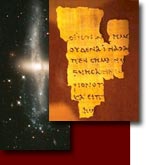| Site Map | Contacts | Links | Newsletter | |
Genesis:
Was There An Historic Adam?
There are three different ways the Hebrew word "adam" is used in Genesis. "Adam" can just mean the generic term for mankind in general, or male in particular. In Genesis 1:27 the term "Adam" includes both male and female referring to all humanity. In Genesis Two "Adam" refers to a male in contrast to a female. The second use is a historical person named Adam. Hess states that not until chapter 4:25 is a historical person meant (Hess 1997, 31). The third use of "Adam" as a title, is seen in ancient Near Eastern parallels where the lu-sign for ruler means "man" (Hess 1990, 7).The Hebrew Adam and the Sumerian Adam are similar in usage. Both can mean humans or humanity (Hess 1993, 18). A.W. Sjoberg suggests that Adam, a-meaning arm or side, and dam meaning spouse, must be a Canaanite loanword in Sumerian (Ibid.). The Hebrew word eve means to live. The Sumerian logogram TI, meaning to enliven, is also a homonym for the word rib (Ibid., 20). As a general rule in the Hebrew, when Adam has a definite article, it means man or human; while Adam with no article is a personal name (Hamilton 1990, 159).
The name "Adam" in Genesis seems to be a word play with the name for "ground, adamah" from which man was formed (Hess 1997, 31). The Hebrew root word for "Adam" means "red" (Hess 1993, 15).
The historical Adam may be the same man named "Allum" the first king in the Sumerian King List, see The Weld-Blundell Prisim, who lived before the great flood. He was the first king of Eridu which may be the Biblical Eden. The Sumerians of Mesopotamia are the oldest known civilization. Adam is also equated with Adapa, the first sage of Eridu (Shea 1977, 27; Fischer 1996, 308). Shea explains that the "p" in Adapa could change to "m" in Hebrew giving the name Adama (Ibid., 37).
The other key word is the meaning of "image." Is this to be taken physically or spiritually? The preposition "B" in this phrase means "According to, after the pattern of" (Wenham 1987, 29). A close parallel is in Exodus 25:40 where Moses is told to build the tabernacle "after the pattern" seen on the mountain.
There are five main views of the meaning of "image." (1) The likeness is two aspects of man's nature. This is according to early Christian views like Irenaeus. (2) The image refers to the mental or spiritual side of man. (3) It is the ability to relate to God, to have a relationship with God. (4) The image makes man God's representative on earth. Man is God's vice-regent on earth. (5) The image is physical. In the ANE (Ancient Near East) kings were considered to be the "image of God" even the very "son of God." This does not mean the king looked like God but describes the kings divine right and function as ruler. It seems that view 4 can be combined with view 5. The king is ruling in God's place. Man is to rule over all of creation on earth (verse 26). This same word "image" is used in Genesis 5:3 when Seth is "after his (Adam's) image." Although man had much in common with animals, it was being in the "image of God" that made him different (Wenham, 30). It seems the Hebrews have democratized the "image of God" to refer to all mankind, and not just the king.
Next - Did the Ancients Live Longer?
Bibliography
